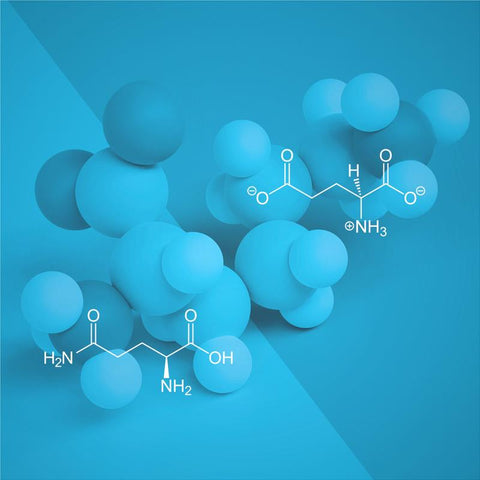
Glutamine and glutamate are two critical amino acids, and the most abundant found in the blood. Both play essential roles in cell survival in the nervous system and are integral in overall human metabolism, health, and disease [1,2]. While both share some similarities due to their status as amino acids, they differ substantially in their chemical structure, biological function, and physiological importance.
In this article, we will explore the differences and similarities between glutamine and glutamate, as well as discuss their metabolic roles, nutritional significance, and clinical applications. Enhancing our understanding of these two compounds will help clarify their use across various health-related fields, such as performance nutrition and clinical medicine.
What are Glutamine and Glutamate?
Glutamine and glutamate are non-essential amino acids, meaning that the body can synthesize them from other compounds. Therefore, they are not required to be consumed through food and drink in the diet. However, they serve divergent roles in the body due to their structural differences.
Glutamine (C₅H₁₀N₂O₃) is the amide of glutamic acid (glutamate). It has an amine functional group attached to the side chain of the molecule, making it more neutral and less reactive compared to glutamate. Glutamine is considered one of the most abundant amino acids in the bloodstream and plays vital roles as a substrate for protein synthesis, anabolic precursor for muscle growth, acid-base balance in the kidney, substrate for ureogenesis in the liver, substrate for hepatic and renal gluconeogenesis, an oxidative fuel for intestine and cells of the immune system, inter-organ nitrogen transport, precursor for neurotransmitter synthesis, precursor for nucleotide and nucleic acid synthesis, and precursor for glutathione production. Many of these functions are connected to the formation of glutamate from glutamine [2].
Glutamate (C₅H₉NO₄), also known as glutamic acid, carries a negatively charged carboxyl group on its side chain, making it an excitatory neurotransmitter in the central nervous system (CNS). Glutamate is a critical molecule in brain function, including learning and memory. It also serves as a metabolic precursor to gamma-aminobutyric acid (GABA), the major inhibitory neurotransmitter in the CNS. Glutamate is also involved in the regulation of the gut-brain axis, a bi-directional connection pathway between the CNS and the gut [3].
How are Glutamine and Glutamate Metabolized?
Glutamine is an important nitrogen donor in the body, essential for synthesizing nucleotides (i.e., DNA and RNA), amino acids, and other nitrogen-containing compounds. It is synthesized in the muscle tissue, lungs, and brain from glutamate through the enzyme glutamine synthetase. Glutamine is a key energy source for rapidly dividing cells such as immune cells and intestinal enterocytes. It also helps regulate acid-base balance by transporting ammonia, a by-product of protein catabolism, safely to the kidneys for excretion, such as urea.
Glutamine shuttles nitrogen between tissues (i.e., from glutamine-producing tissues such as muscle) to glutamine-consuming tissues [4]. It is essential during states of high metabolic stress, such as infection, injury, or illness. During these states, our requirements for glutamine increase to a considerable degree, and the amino acid is consumed at a faster rate than it can be produced. Glutamine is liberated from muscle tissue faster than it can be replaced, as the rate of use by other important tissues increases as well [4].
Glutamate is a pivotal metabolite in both cellular metabolism and brain function. It is involved in protein synthesis, as well as the transamination reactions that form other amino acids. Glutamate also serves as a precursor to the antioxidant glutathione, which protects cells from oxidative stress.
Glutamate is the most abundant excitatory neurotransmitter in the brain [5], where it binds to several types of receptors, including NMDA, AMPA, and kainate receptors, to modulate synaptic plasticity and neuronal communication. It plays a key role in learning, memory, and neural development [6]. However, excessive glutamate release or improper clearance can lead to excitotoxicity, a phenomenon where neurons become damaged and die due to prolonged activation of glutamate receptors, which is implicated in neurological diseases like Alzheimer’s and stroke.
The Nutritional and Clinical Importance of Glutamine and Glutamate
Glutamine is particularly important in clinical nutrition, especially in settings involving catabolic stress, such as surgery, trauma, burns, or critical illness [7,8]. Supplementation with glutamine is often used to support recovery in critically ill patients due to its role in immune function and gut health. Glutamine is essential for maintaining the integrity of the intestinal barrier. It has been shown to improve intestinal barrier integrity and reduce the risk of infections by supporting immune cell proliferation and reducing inflammation [9]. It is widely used in parenteral (IV) nutrition to support patients who cannot obtain adequate nutrition through their normal food intake [10]. It is the primary energy source for intestinal epithelial cells, making it crucial in conditions such as inflammatory bowel disease (IBD) and short bowel syndrome [11]. In critically ill patients, there is some evidence that supplementation can improve gut permeability [12].
Glutamate occurs naturally in foods such as meat, dairy, and certain vegetables, but it is also widely used as a food additive in the form of monosodium glutamate (MSG) to enhance flavor, with some debate as to its safety [13,14]. Glutamate’s role in neurotransmission makes it a critical target in neurological and psychiatric disorders. However, excessive glutamate activity is associated with neurodegenerative diseases, so interventions aimed at modulating glutamate levels are of significant interest. Glutamate excitotoxicity is implicated in conditions such as Alzheimer's disease, amyotrophic lateral sclerosis (ALS), stroke, and epilepsy [15,16]. Therapeutic strategies targeting glutamate receptors or their metabolism are being investigated as potential treatments to reduce neurodegeneration and brain damage following ischemic events like strokes. Medications that block glutamate receptors, such as NMDA receptor antagonists, are used in the treatment of conditions like depression and schizophrenia. For example, in low doses the drug ketamine, an NMDA receptor antagonist, has shown antidepressant effects, demonstrating the therapeutic potential of targeting glutamatergic signaling pathways [17].
Is it Safe to Supplement with Glutamine and/or Glutamate?
Glutamine supplements are widely available and generally considered safe when taken in recommended doses. However, excessive supplementation may lead to potential and substantial side effects [18].
Glutamate supplementation is less common due to its abundance in the diet and potential for excitotoxicity [19]. MSG supplements are used primarily for flavor enhancement rather than health benefits, and safety concerns arise mainly in individuals with sensitivity to MSG. Excessive glutamate intake can also contribute to neurotoxicity, especially in vulnerable populations with pre-existing neurological conditions.
Summary
In this article, we have discussed how glutamine and glutamate are two amino acids with distinct roles in human health. Glutamine serves primarily as a nitrogen donor and as an energy source for immune and intestinal cells, making it vital during periods of metabolic stress. By contrast, glutamate functions predominantly as an excitatory neurotransmitter and plays a fundamentally important role in brain health, but its excessive activity can lead to neurological issues. Both amino acids have significant nutritional and clinical applications, and understanding their roles is crucial for optimizing their use in the context of health and disease.
References
[1] D. Zhang, Z. Hua, Z. Li, The role of glutamate and glutamine metabolism and related transporters in nerve cells, CNS Neurosci Ther 30 (2024) e14617. https://doi.org/10.1111/cns.14617.
[2] P. Newsholme, J. Procopio, M.M.R. Lima, T.C. Pithon‐Curi, R. Curi, Glutamine and glutamate—their central role in cell metabolism and function, Cell Biochemistry & Function 21 (2003) 1–9. https://doi.org/10.1002/cbf.1003.
[3] V. Filpa, E. Moro, M. Protasoni, F. Crema, G. Frigo, C. Giaroni, Role of glutamatergic neurotransmission in the enteric nervous system and brain-gut axis in health and disease, Neuropharmacology 111 (2016) 14–33. https://doi.org/10.1016/j.neuropharm.2016.08.024.
[4] B.A.C. Van Acker, M.F. Von Meyenfeldt, R.R.W.J. Van Der Hulst, K.W.E. Hulsewé, A.J.M. Wagenmakers, N.E.P. Deutz, I. De Blaauw, C.H.C. Dejong, B.K. Van Kreel, P.B. Soeters, Glutamine: The Pivot of Our Nitrogen Economy?, J Parenter Enteral Nutr 23 (1999). https://doi.org/10.1177/014860719902300512.
[5] M.M. Pal, Glutamate: The Master Neurotransmitter and Its Implications in Chronic Stress and Mood Disorders, Front Hum Neurosci 15 (2021) 722323. https://doi.org/10.3389/fnhum.2021.722323.
[6] G. Riedel, Glutamate receptor function in learning and memory, Behavioural Brain Research 140 (2003) 1–47. https://doi.org/10.1016/S0166-4328(02)00272-3.
[7] Y. Sun, S. Zhu, S. Li, H. Liu, Glutamine on critical-ill patients: a systematic review and meta-analysis, Ann Palliat Med 10 (2021) 1503–1520. https://doi.org/10.21037/apm-20-702.
[8] A. Apostolopoulou, A.-B. Haidich, K. Kofina, W. Manzanares, E. Bouras, G. Tsaousi, C. Stoppe, T.I. Dardavessis, M. Chourdakis, Effects of glutamine supplementation on critically ill patients: Focus on efficacy and safety. An overview of systematic reviews, Nutrition 78 (2020) 110960. https://doi.org/10.1016/j.nut.2020.110960.
[9] N. Achamrah, P. Déchelotte, M. Coëffier, Glutamine and the regulation of intestinal permeability: from bench to bedside, Current Opinion in Clinical Nutrition & Metabolic Care 20 (2017) 86–91. https://doi.org/10.1097/MCO.0000000000000339.
[10] P.E. Wischmeyer, R. Dhaliwal, M. McCall, T.R. Ziegler, D.K. Heyland, Parenteral glutamine supplementation in critical illness: a systematic review, Crit Care 18 (2014) R76. https://doi.org/10.1186/cc13836.
[11] M.-H. Kim, H. Kim, The Roles of Glutamine in the Intestine and Its Implication in Intestinal Diseases, Int J Mol Sci 18 (2017) 1051. https://doi.org/10.3390/ijms18051051.
[12] Z.V. Shariatpanahi, G. Eslamian, S.H. Ardehali, A.-R. Baghestani, Effects of Early Enteral Glutamine Supplementation on Intestinal Permeability in Critically Ill Patients, Indian Journal of Critical Care Medicine 23 (2019) 356–362. https://doi.org/10.5005/jp-journals-10071-23218.
[13] K. Niaz, E. Zaplatic, J. Spoor, Extensive use of monosodium glutamate: a threat to public health?, EXCLI Journal; 17:Doc273; ISSN 1611-2156 (2018). https://doi.org/10.17179/EXCLI2018-1092.
[14] A. Zanfirescu, A. Ungurianu, A.M. Tsatsakis, G.M. Nițulescu, D. Kouretas, A. Veskoukis, D. Tsoukalas, A.B. Engin, M. Aschner, D. Margină, A Review of the Alleged Health Hazards of Monosodium Glutamate, Comp Rev Food Sci Food Safe 18 (2019) 1111–1134. https://doi.org/10.1111/1541-4337.12448.
[15] E. Foran, D. Trotti, Glutamate transporters and the excitotoxic path to motor neuron degeneration in amyotrophic lateral sclerosis, Antioxid Redox Signal 11 (2009) 1587–1602. https://doi.org/10.1089/ars.2009.2444.
[16] M.R. Hynd, H.L. Scott, P.R. Dodd, Glutamate-mediated excitotoxicity and neurodegeneration in Alzheimer’s disease, Neurochem Int 45 (2004) 583–595. https://doi.org/10.1016/j.neuint.2004.03.007.
[17] D.R. Lara, L.W. Bisol, L.R. Munari, Antidepressant, mood stabilizing and procognitive effects of very low dose sublingual ketamine in refractory unipolar and bipolar depression, Int J Neuropsychopharmacol 16 (2013) 2111–2117. https://doi.org/10.1017/S1461145713000485.
[18] M. Holecek, Side Effects of Long‐Term Glutamine Supplementation, J Parenter Enteral Nutr 37 (2013) 607–616. https://doi.org/10.1177/0148607112460682.
[19] F. Martami, K.F. Holton, Targeting Glutamate Neurotoxicity through Dietary Manipulation: Potential Treatment for Migraine, Nutrients 15 (2023) 3952. https://doi.org/10.3390/nu15183952.





Comments (0)
There are no comments for this article. Be the first one to leave a message!